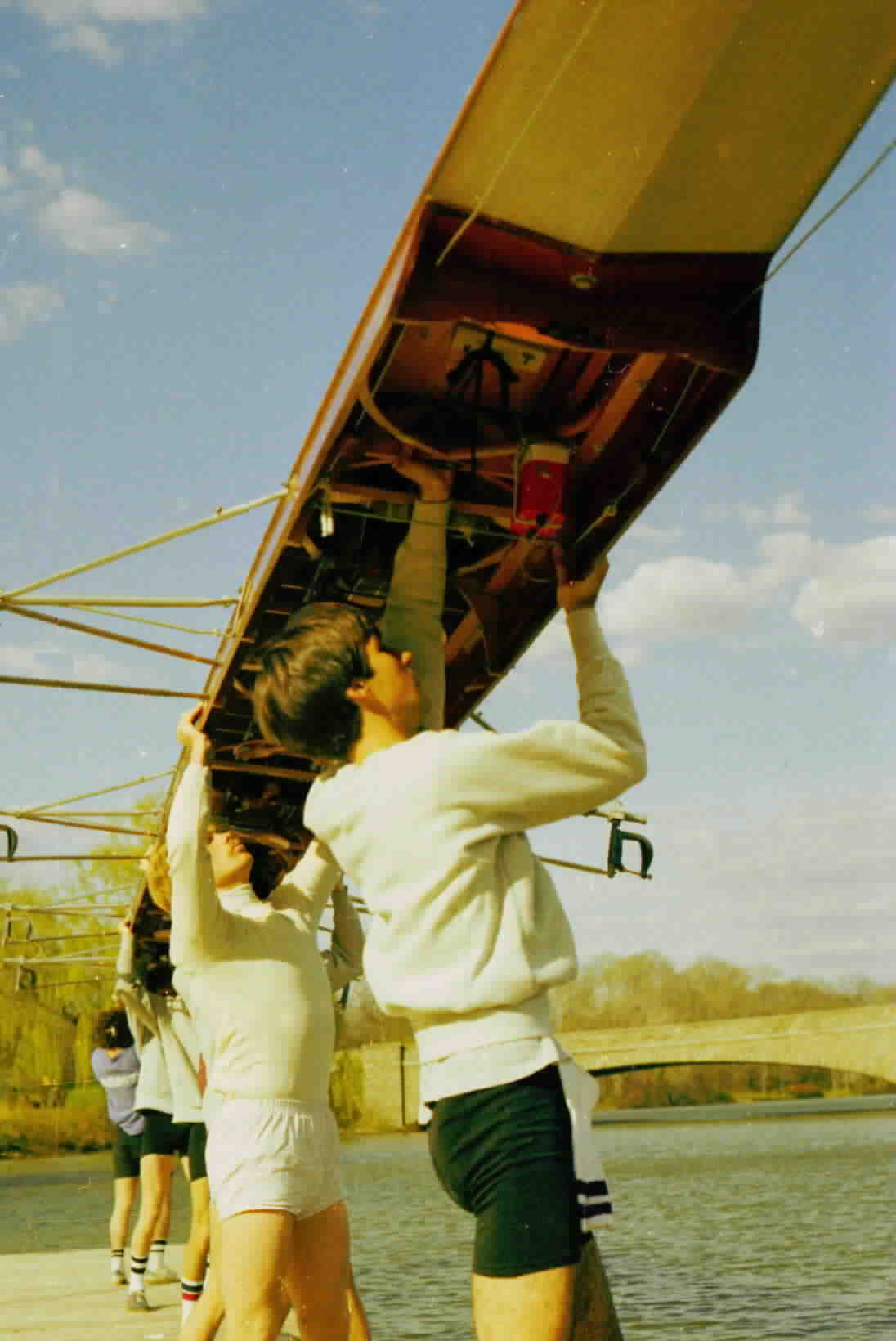






BIAC: Crew, Coxswains, Boat Handling & Terms |
|
Crew: Shells and equipment Rowing boats (shells) and equipment these days are pretty hi-tech while still very basic. Shells can have one, two, four, or eight rowers. See the Shell Terms below for details. These racing craft can get moving fast - sometimes 15 mph - with an experienced crew.
The rowing machines (ergometers) seen in health clubs are great for the rowing motion and physical conditioning, but give no sense of the balance, timing, or oar bladework required on the water. Add in other people and you have a sport that demands both individual and team excellence. Shells vary in length from 24 to 27 feet (for a single) to 45 feet (for a four), to almost 60 feet in length (for a full eight). Each shell weighs from 35 to 210 pounds, or roughly 10 + (R*25) where R is the number of rowers in the boat. Shells are pretty skinny at the beam (12-21 inches) but with riggers each shell spans about 5.5 feet in width. You will find a blend of carbon fiber, fiber glass, and wood in each shell according to the state of the art in material science of the times and preferences of the shell architect. A new single shell can cost as little as $4,000 while a new eight can easily reach $30,000. Shells of four and eight people get a bonus of an extra person in the boat who doesn't row. Coxswains face forward, steer, and coach the boat to perfection.
"Hands On!" is a call to order by the coxswain to the rowers. The crew should become alert and be ready to handle expensive equipment safely after 'Hands On!' is heard. All unnecessary talk should end at this moment. Attention should be given to the coxswain until all equipment is returned home: shells and oars. "Weigh Enough!": This means 'stop', on or off of the water. All rowers should be attentive and may alert of any potential collisions by giving the 'weigh enough' command . The coxswain then becomes responsible for making adjustments to clear the path. The origins of this command have been obscured and you may often see it as "Way Enough". • • Moving: All land movement (boat lifting and carrying) should be done at a moderate and deliberate pace. The crew should slow down any time something feels awkward - make adjustments and if necessary ask the coxswain for assistance. Never allow circumstances to rush you and compromise the safety of the team or boat. • Clear Riggers: When a shell is lifted the crew should be able to see all riggers. Each rower is responsible for making sure the riggers in front of them will clear any obstacles. Ideally the crew will alternate their sides and riggers to facilitate this need. • Clear Bow: The rowers in front or nearest the direction of travel are responsible for making sure the boat/shell will clear any obstacles. All rowers should be attentive and call out any potential collisions as early as possible. • Fins & Slings: When placing a shell into slings be sure to clear the fin or skeg of any load. Fins can break easily under the smallest stress. Try to place your slings and shell in a location that still allows other movement of equipment around you. • Washing: Shells should be rinsed or washed after each row - inside and out. Exterior hulls should be wiped with a soft sponge to remove marine scum and followed with a rinse. Oars (blades and handles) should be rinsed with fresh water too. • Racking: Always place a shell on ribs when racking the boat. Do not rest a shell on it's riggers. When securing a long shell to a rack it should be tied to at three points (front, middle, rear). The ties should serviceable: not torn, cut, or frayed. Shells must be tied down so as to defeat any gust capable of lifting, sliding, or throwing the shell off it's rack. • Hardware check: Rowers are responsible for checking the tightness of nuts on their rigging and foot stretchers before each row and making adjustments accordingly. • Bow and Stern Lights: During twilight rows all shells are required to have lit bow and stern lights. At BIAC each program is currently responsible for supplying this need. We hope to find a favorite solution that will work for all programs this year. Coxswains make calls to tell the crew what to do in any situation. The crew may advise the cox, but the final command is up to him or her. A cox must be alert and in control (of him/herself, the boat, and crew) at all times. The crew should expect to hear a prep call, and an execute call at a consistent cadence comfortable to both the cox and crew. The prep call tells the crew which command they are going to execute. The execute call then performs the required action. Each coxswain and crew will develop calls and cadences unique to the team. Sometimes calls will run together, like “Down to Waist ... and Down !”. Calls like "Weigh enough!" have urgency and therefore no preparation, though a kind cox will time such a command to the rythme of the team. In general, the crew should be responsive to the coxswain's voice and with practice know what is expected from the cox's style, cadence, and tone. All movements by the crew should be done at a moderate and deliberate pace. (i.e., the boat should never be rushed, but at a pace that allows the entire crew to work together.) If the entire crew does not hear/understand a command, the boat should be moved deliberately enough to allow everyone to respond. If you find the boat moving unexpectedly, assist that movement because you may have missed a command. However, call "Weigh enough!" if you believe the movement to be unsafe. If any command is unclear, ask the cox for clarification or get help from a crew mate.
Ready all ... Row! The crew starts rowing together from a static position. On the paddle: Row with little effort just to move the boat slowly. Up/Down to waist: Lift/Lower the shell to waist height Bow: Front of the boat. Shell: Another word for the rowing boat. Single: A scull for one rower (a sculler). Bow: The rower nearest the bow of the boat. When the boat has no cox, as in a double or a quad, the bowman steers the boat and issues commands. Catch: The start of the drive where the oar is placed into the water. Ready all ... row! The command to start rowing. Should be preceded by... (Stroke) Rating: The number of strokes taken per minute. Head Race: Generally a Fall regatta, typically rowing upriver over a winding course covering several miles. Races are timed start to finish, rather than 1:1 parallel racing. |
|
© Bair Island Aquatic Center 2008-2010 -"info at GoBair dot org" |
|
 You row facing backwards using your legs, back, and arms (in that order). You sit on a sliding seat with your feet in stationary shoes or sandals. You use one large oar (about 12.1 feet long) in a 'sweep' style shell and two oars per person in a 'scull' shell (each about 9.3 feet long).
You row facing backwards using your legs, back, and arms (in that order). You sit on a sliding seat with your feet in stationary shoes or sandals. You use one large oar (about 12.1 feet long) in a 'sweep' style shell and two oars per person in a 'scull' shell (each about 9.3 feet long). 

